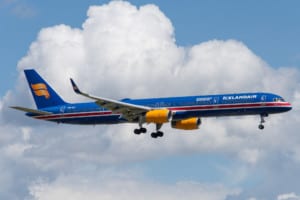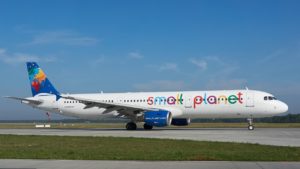The age-old question that has plagued humanity for centuries: which is better, 757 or A321? In this article, we will explore the pros and cons of both planes, and by the end, you will be able to make an informed decision on which one is right for you.
This article will compare the two aircraft side by side and examine their respective features, performance, and cost.
| Aircraft: | Boeing 757-300 | Airbus A321 |
|---|---|---|
| Photo: |
 |
 |
| Country: | United States | France |
| Manufactured: | from: 1998 to: 2004 | from: 1994 to: Present |
| ICAO: | B753 | - |
| Price: | $80 million | $117.4 million |
| Avionics: | Rockwell Collins Avionics | Thales Avionics Suite |
| Engine: | 2x Rolls-Royce RB211-535E4/B, Pratt & Whitney PW2000-40/43 | 2 X CFM56-5 |
| Engine Type: | Turbofan | - |
| Power: | 43,500 pound-force | 56,200 pound-force |
| Max Cruise Speed: |
496 knots 919 Km/h |
542 knots 1,004 Km/h |
| Approach Speed (Vref): | 140 knots | - |
| Travel Range: |
3,467 Nautical Miles
6,421 Kilometers |
3,200 Nautical Miles
5,926 Kilometers |
| Fuel Economy: |
0.3 nautical mile / gallon 0.147 kilometres / litre |
0.45 nautical mile / gallon 0.220 kilometres / litre |
| Service Ceiling: | 42,000 feet | 39,000 feet |
| Rate of Climb: |
3500 feet / minute 17.78metre / second |
- |
| Take Off Distance: |
2600 metre 8,530.08 feet |
1707 metre 5,600.33 feet |
| Landing Distance: |
1550 metre 5,085.24 feet |
1540 metre 5,052.43 feet |
| Max Take Off Weight: |
123,830 Kg 272,996 lbs |
93,500 Kg 206,130 lbs |
| Max Landing Weight: |
101,610 Kg 224,009 lbs |
- |
| Max Payload: |
30,940 Kg 68,210 lbs |
21,725 Kg 47,895 lbs |
| Fuel Tank Capacity: |
11,490 gallon 43,494 litre |
7,841 gallon 29,681 litre |
| Baggage Volume: |
67.5 m3 2,384 ft3 |
51.76 m3 1,828 ft3 |
| Seats - Economy: | 295 seats | 220 seats |
| Seats - Business Class: | 243 seats | 185 seats |
| Seats - First Class: | - | - |
| Cabin Height: |
2.13 metre 6.99 feet |
2.22 metre 7.28 feet |
| Cabin Width: |
3.54 metre 11.61 feet |
3.7 metre 12.14 feet |
| Cabin Length: |
43.21 metre 141.76 feet |
34.44 metre 112.99 feet |
| Exterior Length: |
54.43 metre 178.57 feet |
44.51 metre 146.03 feet |
| Tail Height: | 13.64 metre - 44.75 feet | - |
| Fuselage Diameter: |
3.76 metre 12.34 feet |
3.96 metre 12.99 feet |
| Wing Span / Rotor Diameter: |
38.06 metre 124.87 feet |
34.1 metre 111.88 feet |
| Wing Tips: | Blended Tips | No Winglets |
| More Info: | Boeing 757-300 | Airbus A321 |
|
Data presented is for entertainment purposes and should not be used operationally.
|
Other Boeing 757-300 comparisons:
- Airbus A330-300 vs Boeing 757-300
- Boeing 737-800 vs 757-300
- Boeing 757-300 vs Boeing 777-200ER
- Boeing 787-8 vs 757-300
- Boeing 747-300 vs 757-300
Other Airbus A321 comparisons:
About the Boeing 757
Introduced in 1983, the 757 was designed to replace the 727 models with a lower seat-per-row density. As the 757 was designed for shorter routes, its range is shorter than that of the 767, which is designed for long-haul flights. The 757 can carry between 183 and 289 passengers and has a maximum range of 7,222 kilometers.
It is powered by either Rolls-Royce RB211 engines and has a top speed of 982 kilometers per hour. With a wingspan of 38 meters and a length of 47 meters, the 757 is larger than its predecessor, the 727. As of 2013, the unit cost of a 757 is between 80 and 100 million USD.
Why was it developed and built?
The 757 was designed to replace the aging 727 models. It features a longer range and higher fuel efficiency, making it more suitable for longer routes. Additionally, the 757 is more comfortable than its predecessor due to its larger cabin and better seating.
What purpose did it serve?
The 757 was initially designed to meet the needs of medium-haul routes, such as those connecting smaller cities in Europe and Asia. However, it has since been used in various roles, including services to small airports, charter flights, cargo operations, and even military applications.
About the Airbus A321
The Airbus A321 is a single-aisle, twin-engine airliner with an extended range. It has a maximum range of 5,930 kilometers and can seat up to 186 passengers in a two-class configuration. The A321 has a wingspan of 34 meters and is 45 meters long.
It has a top speed of 876 kilometers per hour and can fly at a cruising altitude of 10,668 meters. The A321 entered service in 1994 with Air Inter and has since been operated by many airlines around the world. It is powered by either CFM International CFM56 or IAE V2500 engines. To date, over 2,700 A321s have been delivered to airline customers worldwide.
Why was it developed and built?
The A321 was developed to replace the aging Airbus A300 and A310 models. It features a longer range, higher fuel efficiency, a larger cabin, and better seating configuration, making it more suitable for medium-haul routes.
What purpose does it serve?
The A321 is primarily used for medium-haul routes, connecting larger cities within the same region. It can also be used on charter flights and cargo operations. Additionally, it has been used in military applications and is even capable of operating from smaller airports due to its shorter takeoff and landing distances.
How are the Boeing 757 and Airbus A321 different?
The Boeing 757 and Airbus A321 are two popular single-aisle airplanes. While they are both used for short to medium-haul flights, there are some key differences between the two models.
The 757 is a longer, wider, and taller airplane than the A321. However, the 757’s fuselage is slightly narrower than the A321’s fuselage. The 757 also has a larger wing area than the A321. These differences give the 757 better fuel efficiency and range than the A321.
The 757 can fly up to 5,545 miles, while the A321 can only fly up to 4,950 miles. Additionally, the 757 can carry more passengers than the A321.
The 757 has a maximum capacity of 239 passengers, while the A321 has a maximum capacity of 220 passengers. Finally, the 757 has a higher operating speed than the A321.
How are the Boeing 757 and Airbus A321 similar?
There are several similarities between the Boeing 757 and Airbus A321. Both airplanes have twin-engine power plants and a single aisle configuration, making them suitable for short and medium-haul flights. Both models also feature a glass cockpit with modern avionics, allowing for greater situational awareness in the air.
What’s better about Boeing 757?
Engine:
The Boeing 757 is powered by two Pratt & Whitney PW2037 or PW2040 engines. This engine provides the aircraft with improved performance and fuel efficiency. It also offers a very high thrust-to-weight ratio, allowing the aircraft to climb and accelerate quickly. This can be especially beneficial during takeoff and when encountering strong headwinds.
Range:
The Boeing 757 has an impressive range of up to 3,900 nautical miles (7,223 km). This makes it capable of serving medium to long-haul routes that other aircraft may not be able to. It can also serve shorter routes without having to refuel, saving time and money.
Economy:
The Boeing 757 has a lower operating cost than many of its competitors. This is due to its efficient engines, advanced aerodynamics, and light weight structure. It also has a higher payload capacity than many of its competitors, allowing it to carry more passengers or cargo. This could result in an increase in revenue for airlines.
What’s better about Airbus A321?
Reliability:
The Airbus A321 is renowned for its reliability and durability. This is due to the use of advanced materials, such as carbon fiber-reinforced plastics, which reduce the overall weight of the aircraft and make it more resistant to corrosion. Additionally, its engines are designed for low maintenance and feature advanced safety features such as autothrottle and auto-braking.
Comfort:
The Airbus A321 features a wider cabin than many of its competitors, allowing for more comfortable seating configurations. Its extra-wide cabin provides passengers with more legroom and allows airlines to offer first-class seats in a single-aisle aircraft. Additionally, its cabin is quieter than many of its competitors, making it a more pleasant experience for passengers.
Cost-Effectiveness:
The Airbus A321 is a cost-effective aircraft for airlines. Its efficient engines and advanced aerodynamics give it a lower operating cost than many of its competitors. Additionally, it can typically seat more passengers than many of its competitors, allowing airlines to maximize their revenue per flight.
Conclusion
The Boeing 757 and Airbus A321 are both excellent aircraft for short to medium-haul flights. The 757 offers superior performance, range, and capacity, while the A321 offers superior reliability and comfort. Ultimately, both aircraft provide airlines with a cost-effective solution for short to medium-haul flights. It is important for airlines to consider the various features of each aircraft to ensure they choose the best option for their specific needs.


